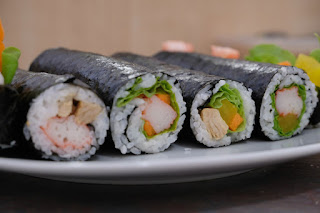It's not simply about substituting a salad for your Friday night pizza.
It's all about making long-term adjustments to your daily meals and learning about what you're eating and why it's healthy for you.
After all, "you are what you eat," as the phrase goes.
As a result, we've taken inspiration from the Japanese diet to aid you on your healthy-eating path to finding new and tasty foods without feeling guilty!
Researchers have linked the Japanese diet to their ability to live longer than practically anybody else on the planet.
Foods high in sea minerals and nutrients, such as fibre, calcium, potassium, magnesium, iron, and vitamins A, C, and E, are included in the traditional Japanese diet.
Learn about the foods that make up the Japanese diet.
XEM THÊM :
Giới Thiệu Dom88 Cub – Cổng Game Bài Siêu Phẩm 2022
Natto
Natto, which is high on many Japanese healthy food lists, is also known for having an unpleasant odor.
It's well worth a shot, whether you agree or not.
Natto has a special enzyme that is beneficial to heart health, as well as vitamins K1 and K2, which help blood coagulation and heart function.
Vitamin K2 is less common in Western diets but is more effective than vitamin K1.
Natto is abundant in protein and dietary fiber, as well as a variety of other vitamins and minerals.
Furthermore, because it is fermented, the nutrients are more easily absorbed.
Natto is an acquired taste, but it has long been a breakfast staple in Japan, especially when blended with green onions and other ingredients.
Oily Fish
You're probably thinking, "Oily?" Healthy?
That is correct!
The oils present in 'blue-backed' fish species are high in beneficial chemicals like DHA and EPA, which are unsaturated fats or "good fats" that are healthy for your skin and hair.
The oils aid in the reduction of cholesterol and the prevention of cardiovascular disease.
Fish oil is also thought to aid with brain growth.
The diet of the island nation is heavily reliant on omega-3-rich oily fish such as "Iwashi" (sardines), "Saba" (mackerels), "Aji" (horse mackerels), and "Sanma" (salmon) (saury).
Green Tea
Green tea is recognized for keeping you alert without making you jittery because it contains the amino acid theanine (or L-theanine), which is specific to tea leaves and helps generate a relaxed yet concentrated mental state while tempering the effects of caffeine in tea.
Green tea tannins provide several health benefits, particularly in terms of cardiovascular health and antioxidant content.
Sencha, hojicha, and matcha are all high in vitamins C and E, as well as potassium, manganese, and calcium.
Matcha, on the other hand, is said to have 10 times the antioxidants of brewed leaves because the full leaf is used.
Green tea has antimicrobial qualities that are beneficial to the gums and teeth.
Sashimi
Raw fish is one of the simplest and healthiest ways to consume it.
Sashimi is sliced raw fish, and Japan is known for its fondness for this light and healthful cuisine.
Fish is high in protein and omega–3 fats, which have been associated to improved blood pressure, brain function, and heart health.
Sashimi is a delicious way to enjoy fish without the extra calories that come with frying or marinating in heavy sauces.
It's just as simple to create at home with the Kasumi VG-10 PRO 13cm Santoku Knife, which allows for exquisitely thin slices.
Your lovely sashimi pieces can be consumed lightly dipped in soy sauce with wasabi or ginger, both of which are healthy additions to the dinner.
Miso
This nutritious Japanese meal is made from fermented soybeans and is high in beneficial bacteria, enzymes, antioxidants, and essential vitamins and minerals.
It's also a complete protein, meaning it contains all of the important amino acids.
It aids in boosting immunity, improving digestion, decreasing cholesterol, preventing osteoporosis, assisting memory and stress, and maintaining healthy skin, according to nutritionists all over the world.
In Japan, there are hundreds of regional miso variants ranging in color from white to yellow to brown and red, and in flavor from mild to strong and salty.
Miso is most typically eaten in soup, but it can also be used in a variety of other dishes.
READ ARTICLES :
fallen-by-lauren-kate-motion-picture
the-witch-part-1-subversion-2018-movie
beautiful-book-covers-id-hang-in-art
7-must-learn-topics-to-keep-up-with






Nhận xét
Đăng nhận xét